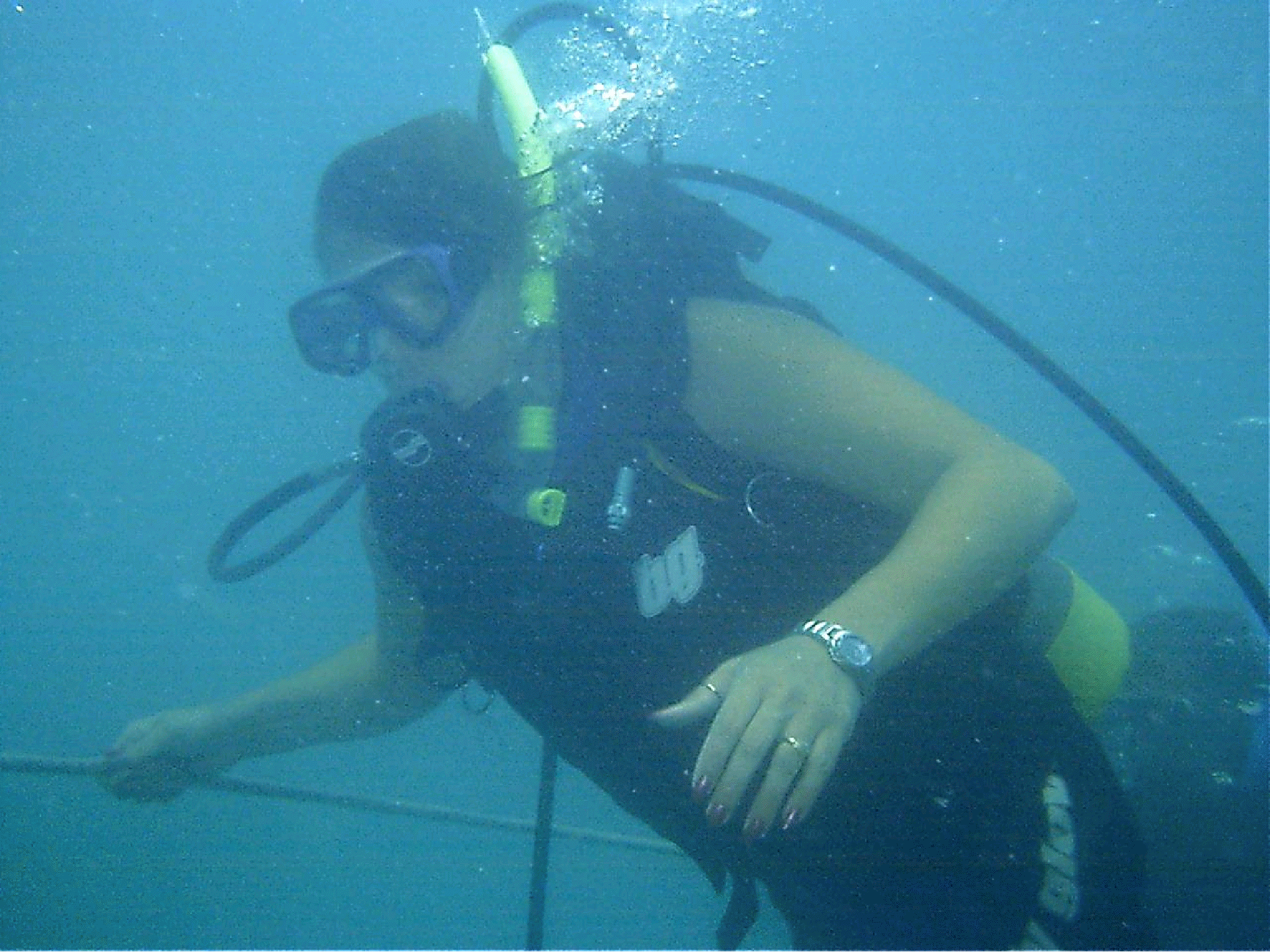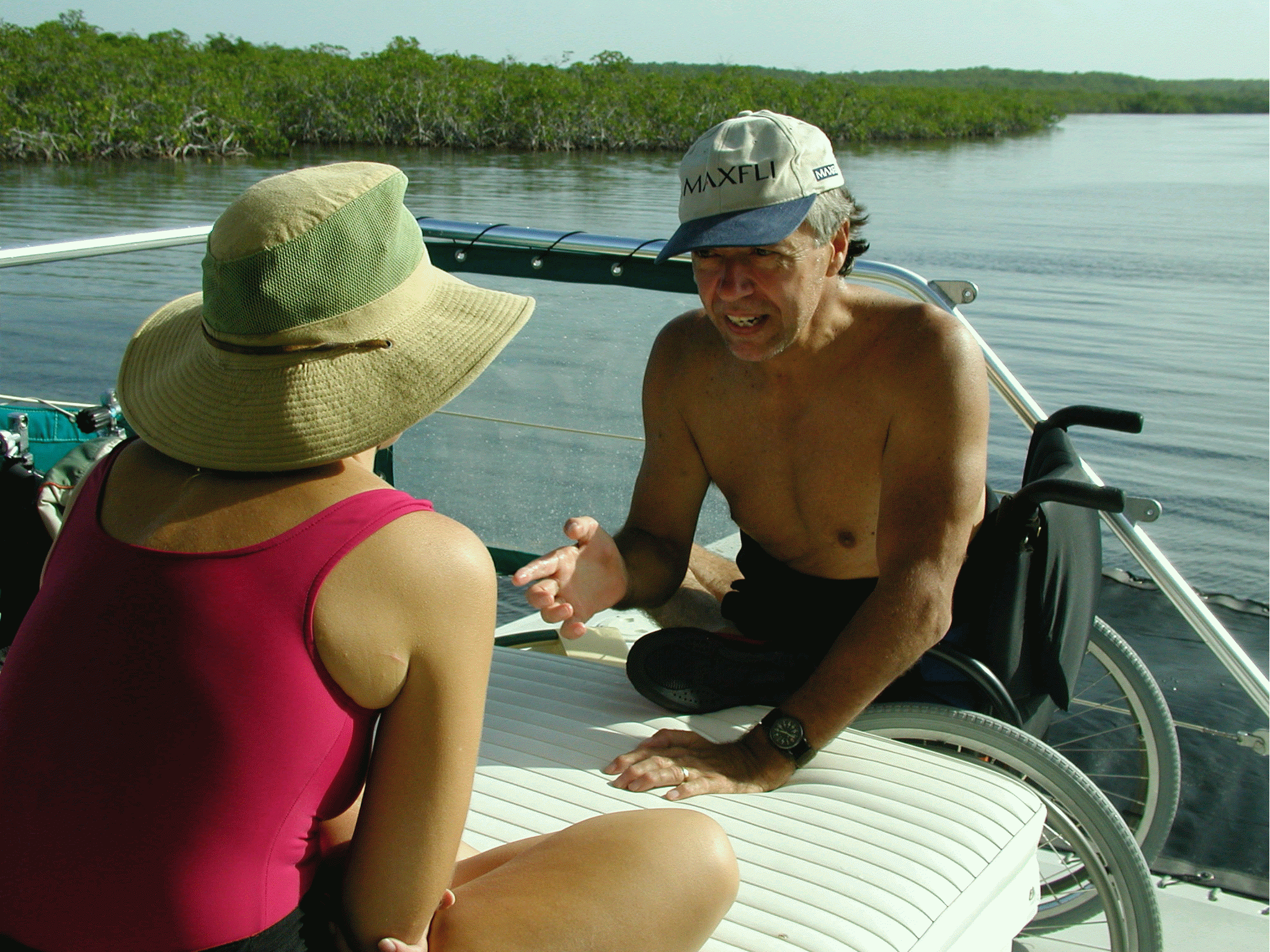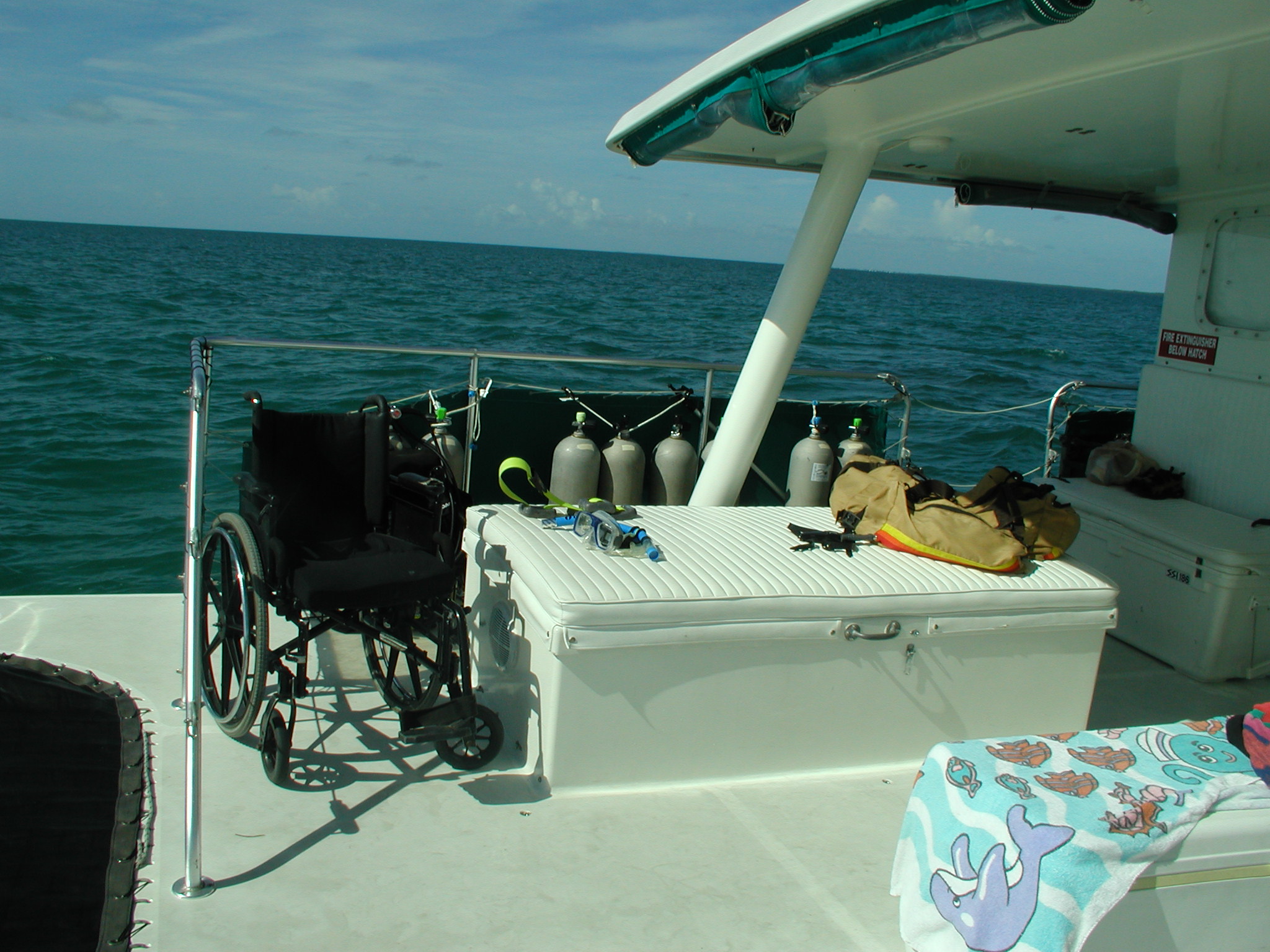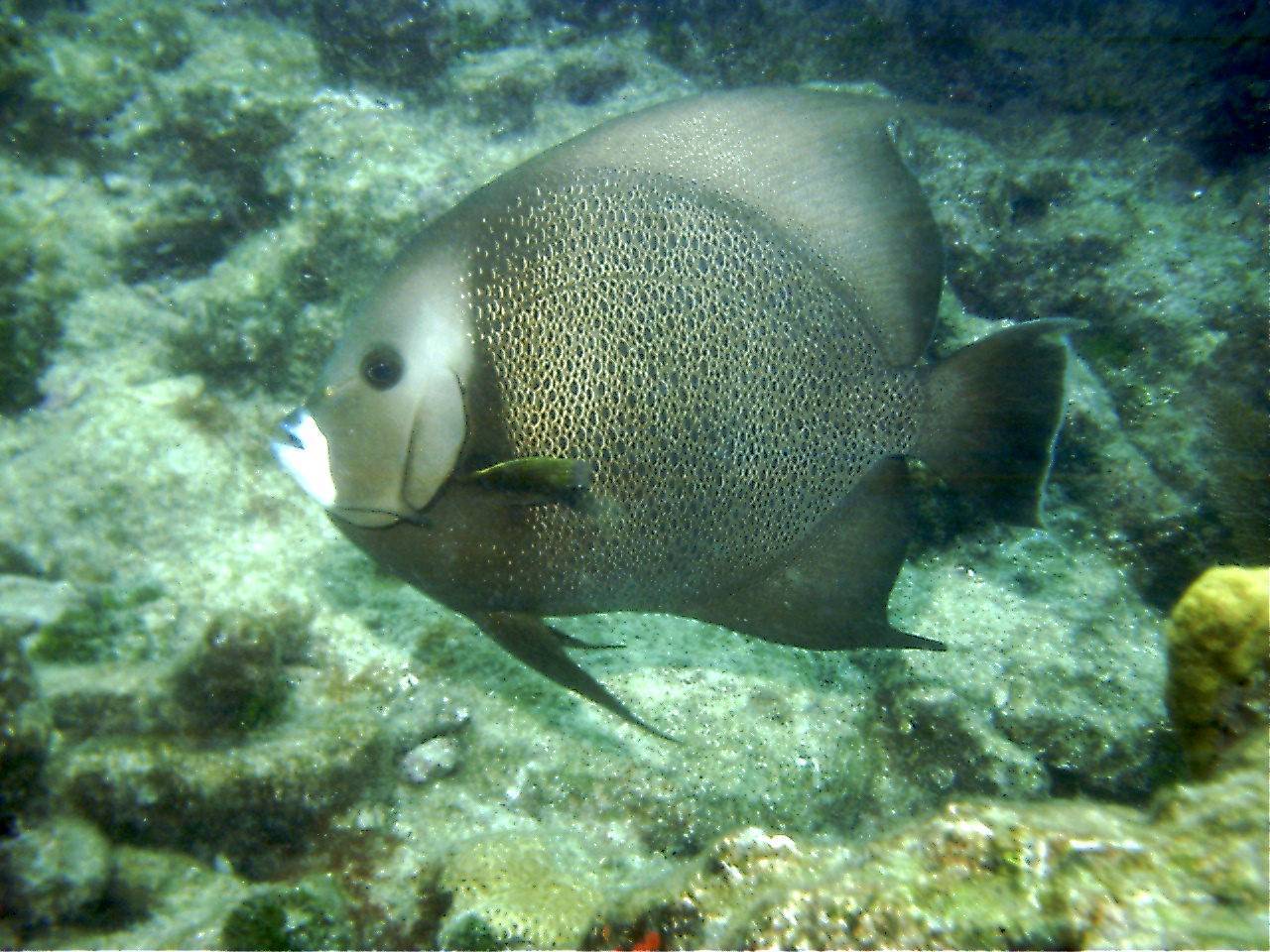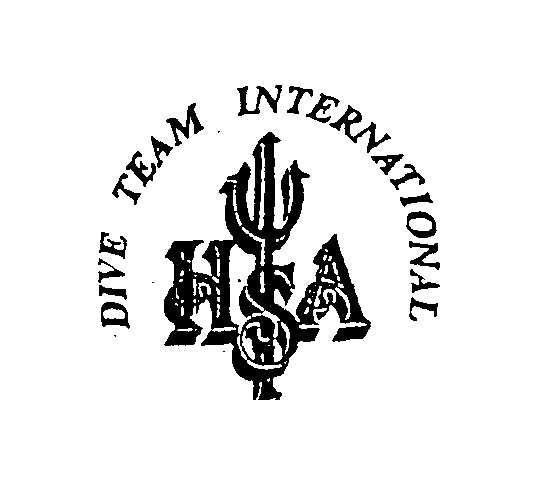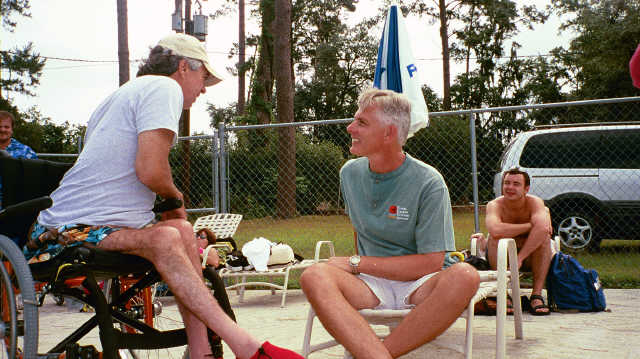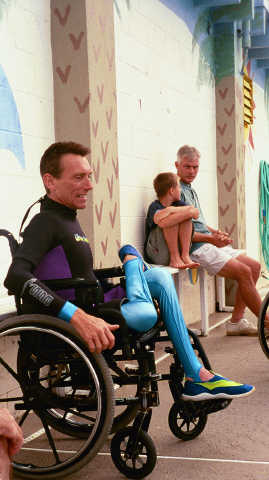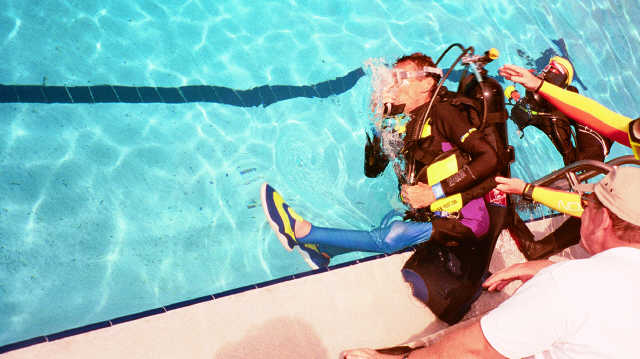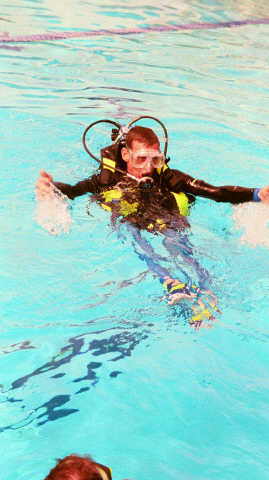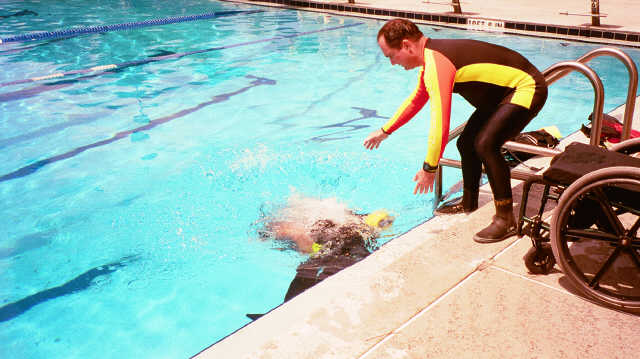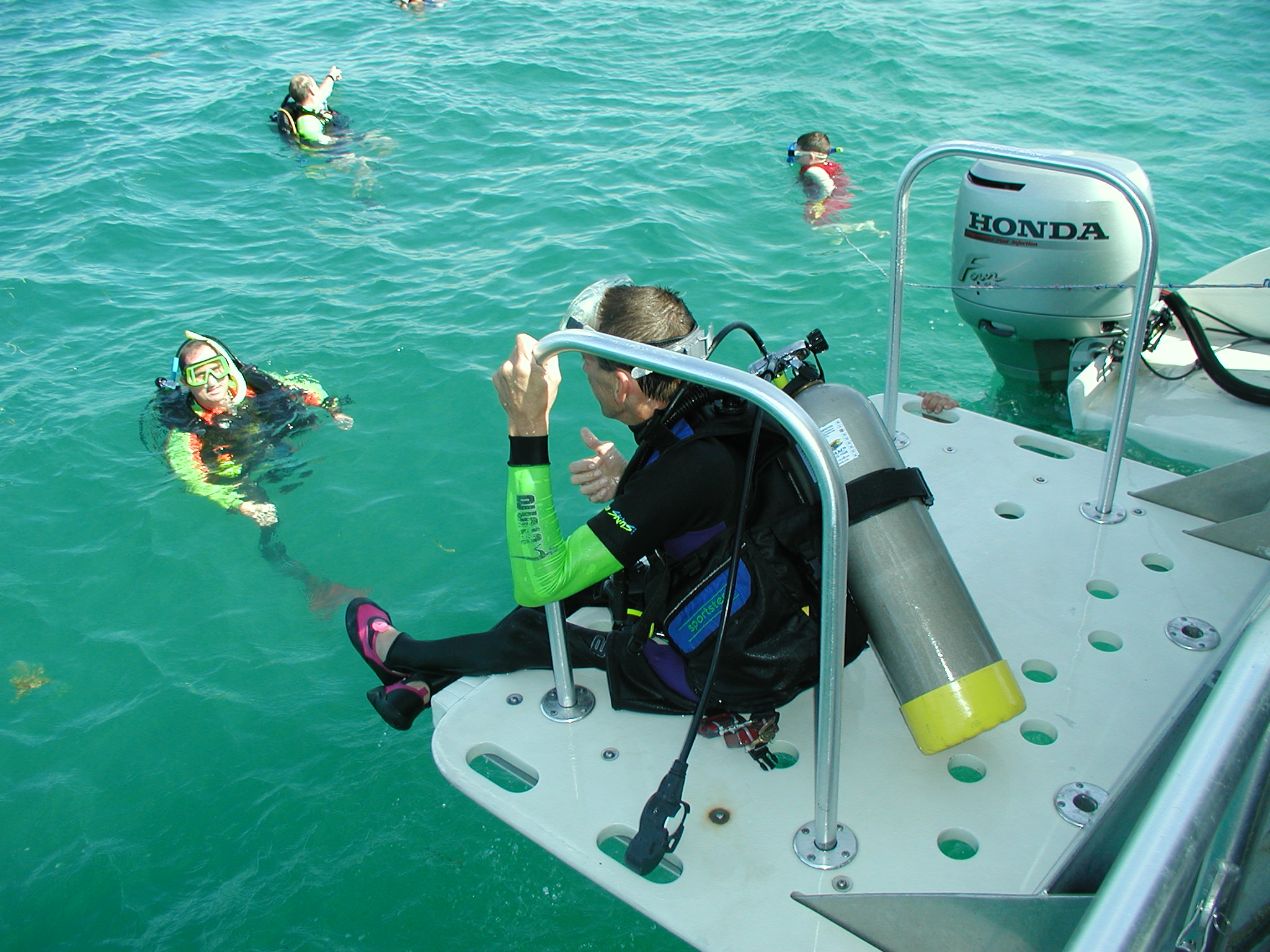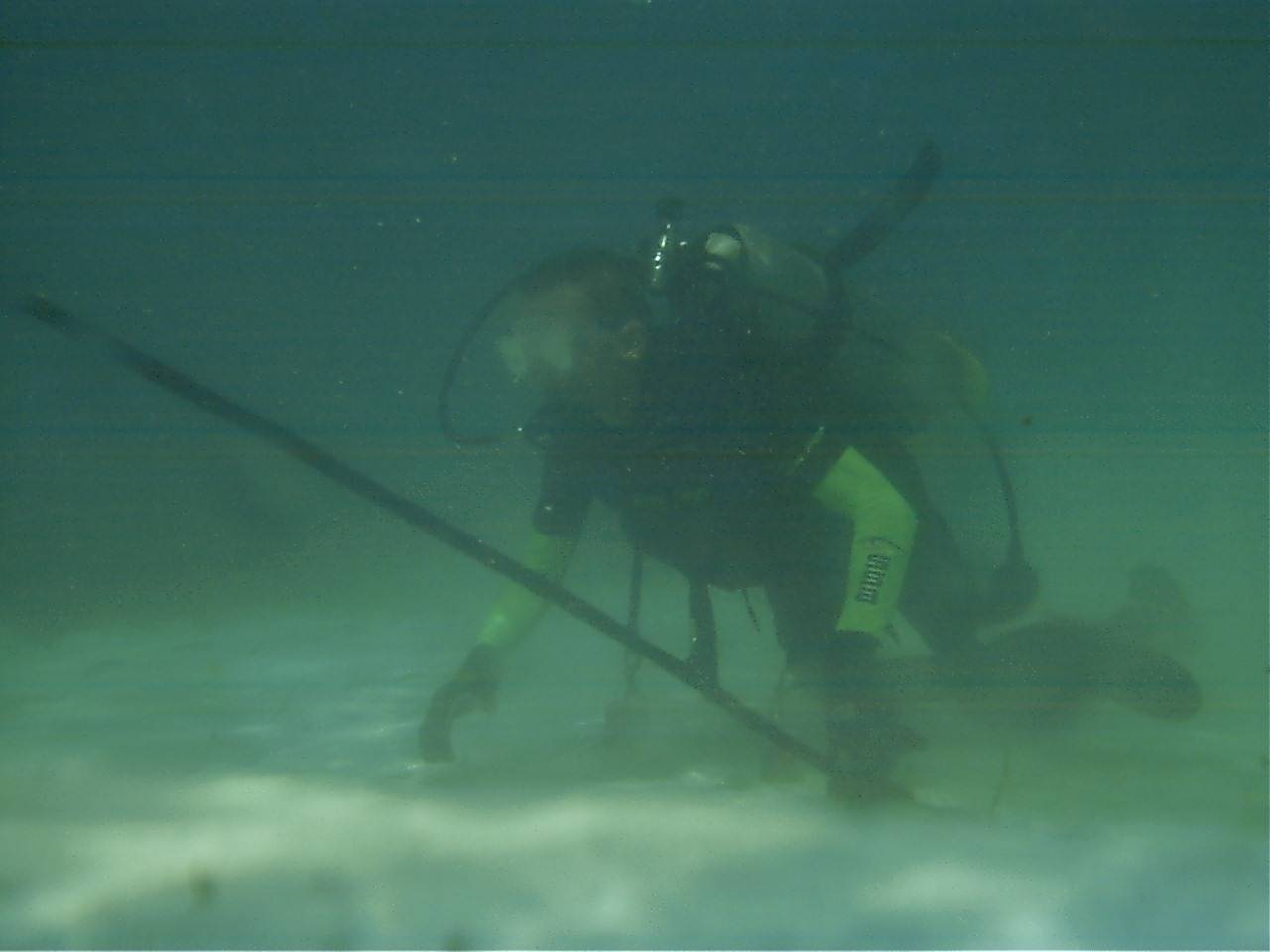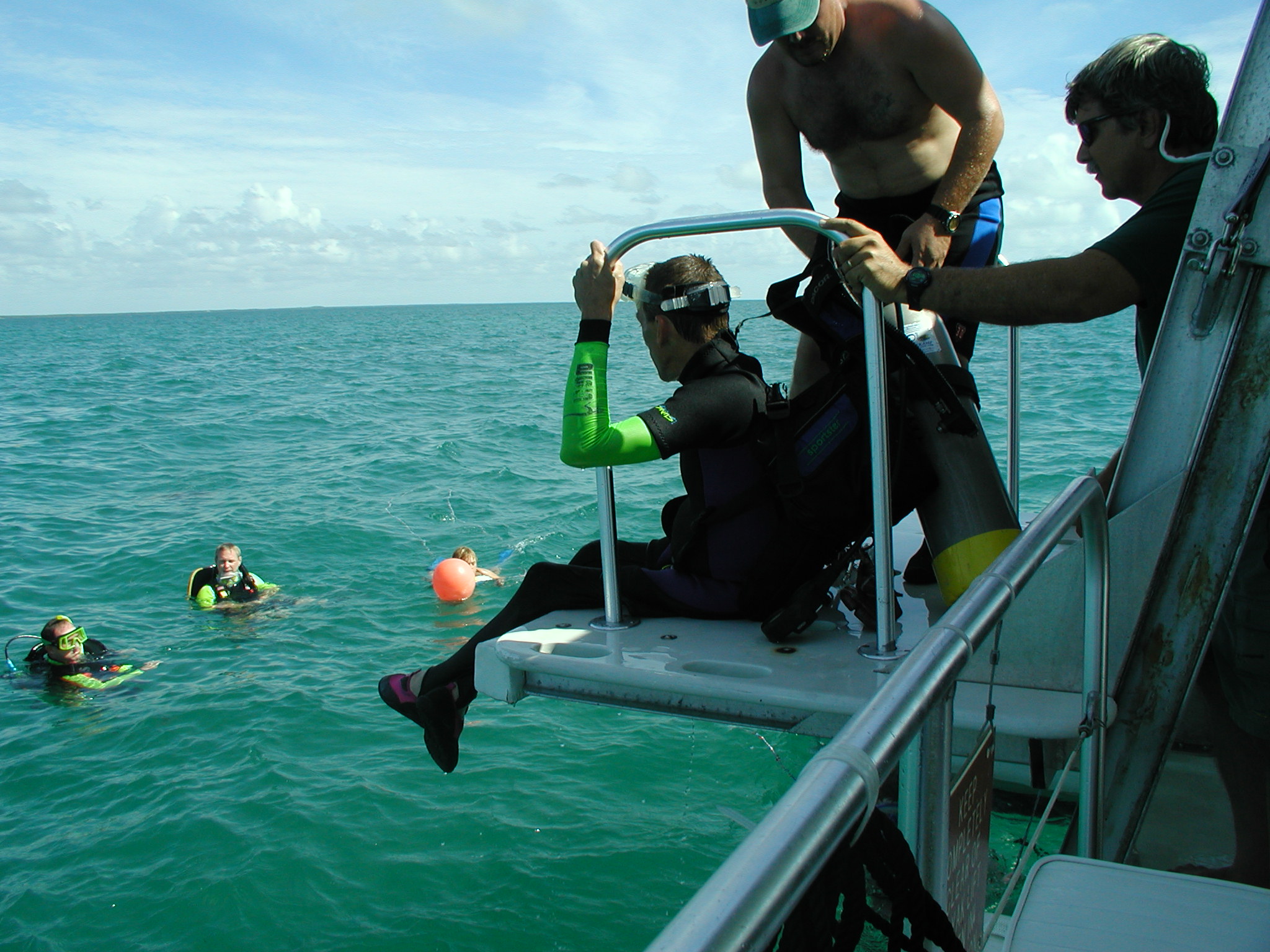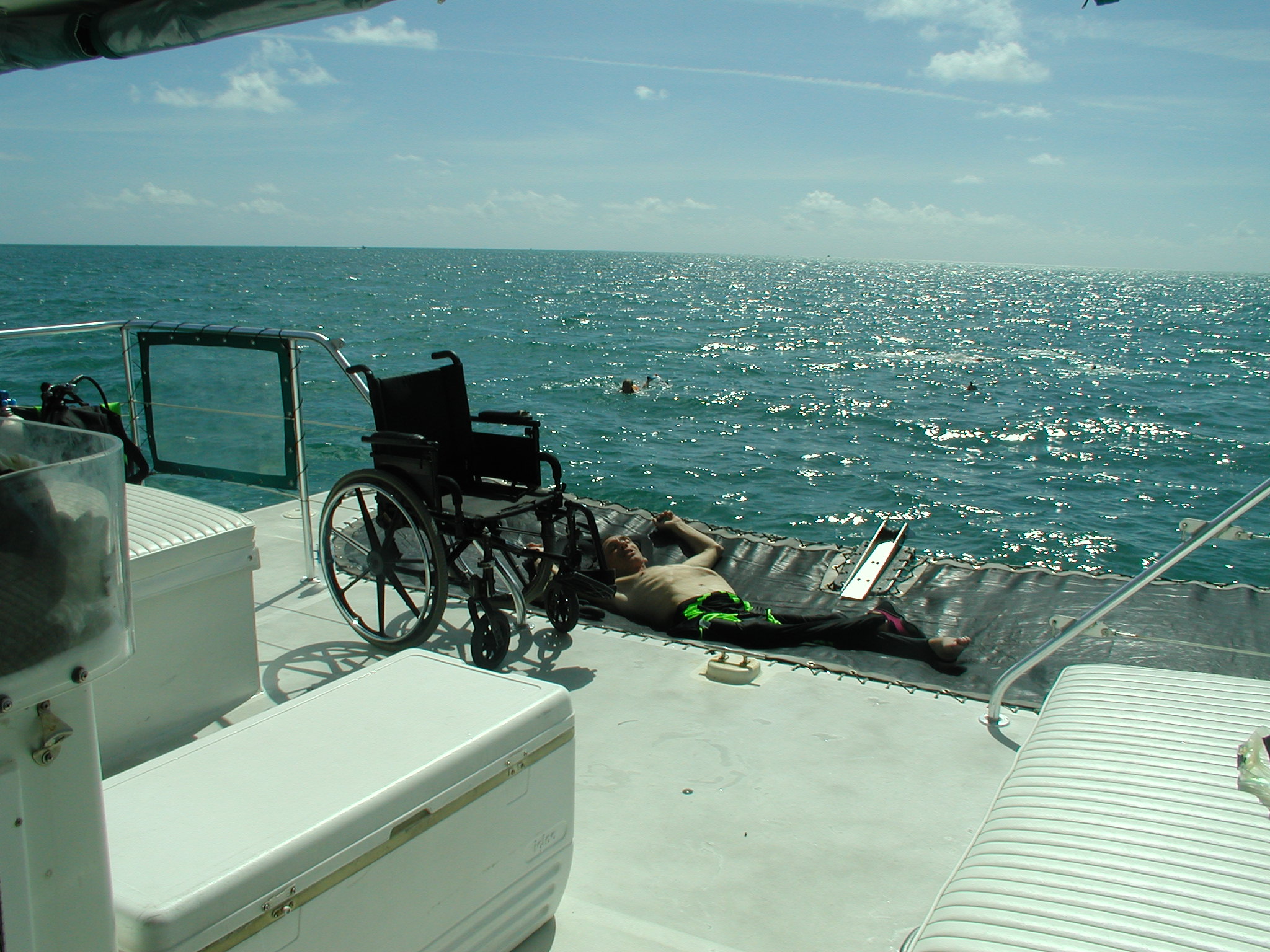POSEIDON HANDICAP SCUBA ADVENTURES
8845 NW 11 th Place Gainesville, FL 32606
POSEIDON HANDICAP SCUBA ADVENTURES
Operating Grant Request
http://phsa.us
The purpose of this non-profit organization is to make available the recreational sport of scuba diving to disabled individuals, so they may have the opportunity to learn and safety enjoy the recreational sport of scuba diving. Handicapped individuals will learn to scuba dive by completing a scuba diving class specifically oriented to individuals with physical disabilities. The class consists of a set of performance standards as set forth by the Handicap Scuba Association (H.S.A.). Upon completion of the course individuals will receive an HSA certification card, which allows the individual to go scuba diving with any recognized scuba diving group or agency based on their HSA Level.
Poseidon Handicap Scuba Adventures (PHSA) being a Tax Exempt organization respectfully requests consideration for a $2,5000 dollars operating grant that offsets the cost of our diving activities.
The Handicap Scuba Association reports that there are approximately 10,000 new spinal cord injuries per year. There is approximately 1 new injury every 60 minutes, with an average age of 19, and 2 out of 3 being males. Keep in mind that only 20% of these young adults will completely rehabilitate and reintegrate into society. For the average person receiving a spinal cord injury, it costs between $100,000 to $300,000 in medical costs by the time they leave rehabilitation. An additional $1.2 million is spent on average, over the person's lifetime on associated secondary medical problems, such as pressure sores, bladder infections and bone fractures. Compared to the cost of rehabilitation and secondary medical care, SCUBA training is very inexpensive, while being a very effective rehabilitation tool, significantly helping the person reintegrate into society. SCUBA diving is a normal activity in a prestigious sport that is not altered for people with disabilities.
The national Spinal Cord Injury statistical center reports that the average yearly health care and living expenses that are directly attributable to SCI for all groups of SCI are $251,885 per person for the first year and $30,676 per person for each subsequent year. Learning the sport of recreational diving greatly adds to rehabilitative efforts and reduces lifetime costs for disabled individuals. According to Ruoti, Morris, and Cole [i], the benefits of Aquatic Rehabilitation are: (1) reduced spasticity, (2) strengthening, (3) increased or maintained range of motion, (4) reduced pain, (5) improved respiratory status, (6) improved peripheral circulation, (7) improved cardiovascular and metabolic status, (8) increased aerobic endurance, (9) improved motor function, (10) positive psychological benefits. Our operating grant will assist in teaching disabled divers this recreational sport, in promoting the benefits of aquatic rehabilitation, and in reducing the lifetime health costs for active disabled individuals.
Aquatic recreation in the water is an enjoyable activity and does not hold the same connotations of hard work and pain that are often associated with "gym therapy". The individual with SCI can work on balance with less fear of falling, stretch and exercise limbs with less pain, and achieve greater mobility with less effort in the water. More specifically, Ruoti, Morris, and Cole report the following benefits of aquatic rehabilitation.
Reduced Spasticity: The neutrality of the water combined with the slow rhythmic rotations and prolonged gentle stretching can relax spastic muscles. The buoyancy of the water eases the constant resistance to gravity that aggravates spasticity.
Strengthening: Good upper extremity strength is vital in day to day functioning of those with SCI. People with incomplete SCI also need to strengthen residual muscles in the lower extremities to reach their maximum potential. Water is an effective tool in strengthening those muscles. Depending on the strength of the muscle, the buoyancy of the water can be used to assist, support, or resist the movement desired. Weaker muscles can be facilitated throughout the range of motion (ROM) by directing the plane of movement slowly across the surface of the water or from the bottom of the pool toward the surface. Stronger muscles can be resisted by increasing the speed of movement that creates turbulence and increases the effect of the water's viscosity against the limb. Buoyancy adds resistance when moving from the surface toward the bottom
Increased or Maintained Range of Motion: Painful, restricted joints can seriously hinder the functional ability of those with SCI. These joints can be mobilized more easily and comfortably in the water. The water reduces pain and relaxes spastic or guarded muscles to allow greater ROM.
Reduced Pain: The sensory stimulation, relaxation, weight relief, and pleasure of being in the water all help to reduce pain and its perception.
Improved respiratory status: Simple immersion with the head out of the water increases the respiratory rate and improves the ventilation perfusion ratio of the lungs. Studies indicate the ventilatory muscle strength and endurance can be improved with training, which aids in the prevention of respiratory failure. Mekarski and Pachalski [ii] performed a 3 year study comparing the cardiorespiratory efficiency of 30 people with paraplegia performing a land based training program compared with 30 people with paraplegia performing a swim training program. Using the Skibinski cardiorespiratory index, they found that there was a significantly greater increase in the vital capacity and decrease in pulse rate in those who participated in the swim training program. The prone position facilitates better use of the diaphragm and lower chest muscles.
Improved peripheral circulation: The hydrostatic pressure gradient during immersion to the neck causes a cephalad shift of peripheral venous blood, augmenting central blood volume and decreasing systemic vascular resistance. Peripheral circulation is improved with better blood supply to the muscles.
This can help reduce the risk of deep vein thrombosis and venous stasis ulcers.
Improved Cardiovascular and Metabolic Status: Simple immersion in water increases cardiac output, stroke volume, and the general metabolic rate. When the body is in the horizontal position there is a reduction in the cardiovascular load. Regular exercise in water has been shown to increase high density lipoprotein cholesterol levels in those with paraplegia, an important factor in reducing the risk of coronary artery disease.
Increased Aerobic Endurance: Haas and colleagues state that, "Although SCI subjects have an impaired adaptation to exercise, an increase in an individual's activity is strictly correlated to the corresponding increase in physical fitness, suggesting that training effects can be obtained in these subjects. "Nilsson and
co-workers demonstrated in a study of seven people with long standing paraplegia that strengthening and endurance training can improve aerobic power, maximal work capacity, and mechanical efficiency. Swimming is one of the activities that can fulfill the requirements for good aerobic training. It is dynamic and uses many muscle groups with a long performance time. It has been shown that those with paraplegia, that a workload of 50% to 60% of the target heart rate (as opposed to 60% to 70% in those without disability) contributes to the maintenance of cardiovascular fitness. Because of the disruption of the sympathetic acceleratory effects of the heart, it may be impossible to reach the target heart rate during exercise. Diminished sympathetic outflow can also result in a greater dependence on anaerobic energy, which would lead to early onset of fatigue and reduced thermoregulatory capacity.
Improved Function: The ultimate goal of any kind of exercise training for those with SCI is not only good overall health, but also efficient functioning in their day to day life. Reduced fear of falling and lessened pain make the pool an excellent medium for restoring balance and coordination and practicing functional activities. Evenly distributed hydrostatic pressure around the trunk and the buoyant force of water allow the client more time to recover from loss of balance. Rolling, transfers, and sit to stand, can all be practiced and facilitated in the pool.
Psychological Benefits: Sir Ludwig Guttmann stated, "Every person who has suffered severe injury or illness develops certain adverse psychological reactions. They may resign into disability and become self centered and anti social. Nothing can prevent and counteract these adverse psychological reaction more than two measures; regular work and sports". A person with SCI will often discover a new enthusiasm after learning water activities. Researchers using the Profile of Mood Survey have discovered that the short term effects after pool therapy include diminished tension, depression, anger, confusion, and improved vigor.
Aquatics can foster a growth of independence and self expression, and give people with disabilities an opportunity to mix with the rest of society.
Ruoti, Morris, and Cole; Aquatic Rehabilitation; 1995
Study cited in the above reference.
Handicap Scuba Association - Open Water Multilevel Certification:
Based on the student's ability to successfully challenge the HSA Physical Performance Standards, the H.S.A. developed the Multilevel Certification, a performance-based method of assessing and accommodating the disabled diver's specialized needs. The basic theory for this type of certification is:
Level A.
The student has successfully challenged all of the H.S.A. physical Performance Standards, demonstrating that he or she can safely scuba dive, solve basic personal emergencies, help another diver in distress, and perform basic rescues.Level B.
The student has successfully challenged those H.S.A. Physical Performance Standards that demonstrate their ability to safely scuba dive, and to solve basic emergencies. However, they are unable to successfully challenge those Performance Standards that demonstrate their ability to help another diver in distress.Therefore, the Level B diver is certified to scuba dive with Two Dive Buddies who are certified Level A or above. In the case of an emergency, this system will provide an effective dive buddy for all members of the dive team.
Level C.
The student has successfully challenged those H.S.A. Physical Performance Standards that demonstrate their ability to safely scuba dive. However, they are unable to successfully challenge those performance standards that demonstrate their ability to independently solve basic personal emergencies, or to execute basic scuba skills, such as, descending, swimming underwater, or operating their own BCD (buoyancy control device).Because some of the basic scuba skills must be performed for them by a dive buddy, they are certified to dive with Two Dive Buddies, one certified Level A or above, the other assisting buddy certified at the minimum as a Rescue Diver. This assisting buddy would preferably be an H.S.A. certified Instructor, Assistant Instructor, Dive Master, or Open Water Dive Buddy.
COURSE SYLLABUS
DATE:________________________________________________________________
LOCATION:____________________________________________________________
TEXT:_________________________________________________________________
INSTRUCTOR(S):________________________________________________________
Handicapped Scuba Association
Lecture 1 DATE:______________________ TIME:__________________
Subject: Orientation/Introduction to the Underwater Environment
Reading:______________________________________________
Assignment:___________________________________________
Pool 1 DATE:_______________________ TIME:_________________
Activity: Swim Evaluation/Introduction to Skin Diving
Lecture 2 DATE:_______________________ TIME:__________________
Subject: Physiology/Pressure Effects/SCUBA Equipment
Reading:______________________________________________
Assortment___________________________________________
Pool 2 DATE:_______________________ TIME:__________________
Activity: Wetsuit/Buoyancy/Surface Swim Techniques
Open water I DATE:_______________________ TIME:__________________
Location: Beach Diving
Activity: Fin and Float – Surf Orientation.
Lecture 3 DATE:_______________________ TIME:__________________
Subject: Pressure Effects on Ascent/Effects at depth
Reading:_______________________________________________
Assignment:____________________________________________
Pool 3 DATE:________________________ TIME:__________________
Activity: Skin dive, Buoyancy Adjustments, SCUBA dive Introduction.
Lecture 4 DATE:________________________ TIME:_________________
Subject: Rescue and Emergency Procedures
Reading:_______________________________________________
Assignment:____________________________________________
1987 1999 handicapped Scuba Association International Instructors Manual
Course Syllabus (cont'd)
Pool 4 DATE: _______________________ TIME:___________________
Activity: SCUBA, Entries, Swim/Dive, Buoyancy Control, Ascents, Descents, Regulator
Clear, Mask Flood, Regulator Recovery, Orally Inflate BCD Under water.
Open water 2 DATE:________________________________ TIME:___________________
Location:_______________________________________________
Lecture: Beach Diving/Equipment Use and Handling
Activity: Skin Dive, Beach Entry/Exit,"Swim and'Snorkel
Lecture 5 DATE:________________________TIME:___________________
Subject: Deep Water Diving/Dive Tables
Reading:________________________________________________
Assignment:_____________________________________________
Pool 5 DATE:________________________TIME:____________________
Activity: Warm up; Gloves and Hood, Breathe through Snorkel with water in it. SCUBA;
Entries, Alternate Snorkel and Regulator, Buoyancy Control, Stationary Buddy Breathing,
Check Time, Mask Removal, Emergency Swimming Ascents.
Lecture 6 DATE:________________________ TIME:____________________
Subject: Dive Tables/Dive Planning
Reading:________________________________________________
Assignment:_____________________________________________
Pool 6 DATE:________________________ TIME:____________________
Activity: SCUBA; Buoyancy Control, Buddy Breathing (swimming), Mask Clear, Remove
and Replace Weight Belt Underwater (no surfacing), Breathe through a Free Flowing Regulator.
Openwater 3 DATE:________________________ TIME:____________________
Location:________________________________________________
Activity: SCUBA; Beach Entry/Exit, Buoyancy Check, Underwater Tour
Lecture 7 DATE:________________________ TIME:____________________
Subject: Diving Equipment/Aquatic Life
Reading:_________________________________________________
Assignment:______________________________________________
1997 1999 Handicapped Scuba Association International Instructors Manual
Course Syllabus (cont'd)
Pool 7 DATE:_______________________TIME:____________________
Activity: SCUBA; Regulator Recovery, Mask Removal, Emergency Swimming Ascents (neutral and negative), Buddy Breathe using one Regulator 2d Stage (stationary, swimming,
and. emergency swimming ascent), Buddy Breathe using and Octopus 2d Stage (stationary,
swimming, and emergency swimming ascent), Buoyant Ascent.
Lecture 8 DATE:______________________ TIME:____________________
Subject: Test/Open Discussion.
Pool 8 DATE: _______________________TIME:____________________
Activity: SCUBA; Buddy Tows, 50 foot Horizontal Emergency Swimming Ascent, Swim
50 feet/15m Underwater without a mask.
Openwatcr 4 DATE:_______________________TIME:____________________
Location:_______________________________________________
Activity: Boat Dive; Open Water Checkouts, Underwater Tour.
Pool 9 DATE:_______________________TIME:____________________
Activity: Skin Diving and In Water Rescue, Ventilation while Towing.
Pool 10 DATE:_______________________ TIME:____________________
Activity: SCUBA; Rescue Unconscious Diver from Bottom of Pool, Ventilation while
Towining.
Open water 5 DATE:_______________________ TIME:_____________________
Location:_________________________________________________
Activity: SCUBA; Beach or Boat Entry/Exit, Underwater Navigation.
Open water 6 DATE:_______________________TIME:______________________
Location:_________________________________________________
Activity: Beach or Boat Skin Checkouts and Rescue (ventilation while towing and removing
victim from the water and C.P.R.)
GRADUATION –
CONGRATULATIONS
1987 – 1999 Handicapped Scuba Association
CONFINED WATER LESSON PLANS Lesson 1
Lesson I will introduce and evaluate the following:
Skills Standards Challenged
1. Swimming evaluation 1.A. 1, 2, and 3
2. Introduction to Mask, Snorkel, and BCD 1.B. 1, 3, and 15
3. Introduction to skin diving 1.B. 6[C], 7[C], 8[C], 10, 11, 12[B],
13, 14[B], 16[C]
I. SWIMMING SKILLS EVALUATION
All students should attempt to accomplish the three swimming skills.
This will give the instructor and the student the opportunity to evaluate their comfort level in the water.
(a). swim 220 yards/200 meters without stopping, using any stroke; no time limit.
1.A. 1 Date completed _______________ Incomplete [ ]
(b) survival swim for 10 minutes by treading, bobbing, floating or method best suited to the individual.
1.A.2. Date completed________________ Incomplete [ ]
(c) swim underwater for 50 feet/9 meters or for 30 seconds.
1.A.3 Date completed________________ Incomplete [ ]
2. INTRODUCT1ON TO MASK, SNORKEL, and BCD
(a) Don skin diving equipment. Assemble mask and snorkel, defog and don it and BCD.
1.B.1[R] Date completed________________ Incomplete [ ]
(b) Introduce' Entries and Exits from the water.
1.B.3.[R] Date completed________________ Incomplete [ ]
(c) Explanation and demonstration of Snorkel Clearing using two methods;
breathe and displacement. Practice both methods in shallow water.I.B.15.[R] Date completed________________ Incomplete [ ]
3. INTRODUCTION TO SKIN DIVING
(a) Orally inflate BCD at the surface.
I.B.6.[C SPR] Date completed________________ Incomplete [ ]
(b) Swim at the surface using mask and snorkel.
I.B.12[B SPR] Date completed________________ Incomplete [ ]
(c) Turn over at the surface from the prone to the back to the prone.
Get the legs down and under them to attain and maintain an upright position. (not a Standard)Skill Development Date completed________________ Incomplete [ ]
1987 1999 Handicapped Scuba Association International Instructor’s Manual
(d) Introduce and practice feet first and head first surface dives.
I.B.8[C SPR] Date completed Incomplete [ ]
I.B. 10. [R] Date completed Incomplete [ ]
(e) Equalize pressure in air spaces.
I.B. I I [R] Date completed_______________Incomplete [ ]
(f) Rest motionless at the surface with head above water, using only a BCD.
I.B.7 [C SPR] Date completed Incomplete [ ]
(g) Swimming skills, swim down to and along the bottom.
I.B.12[B-SPR] Date completed Incomplete [ ]
I.B.13 [R] Date completed Incomplete [ ]
(h) Ascend, clear snorkel, and rest at the surface without lifting the face from the water.
I.B. 14[B] Date completed Incomplete [ ]
I.B.15 [R] Date completed Incomplete [ ]
I.B.16[C SPR] Date completed Incomplete [ ]
End of Confined Water.Lesson I
997 1999 Handicapped Scuba Association International Instructors Manual
CONFINED WATER LESSON PLANS Lesson 2
Lesson 2 will introduce and evaluate SCUBA equipment assembly, donning,
buoyancy adjustments, swimming techniques and SCUBA Diving.
Continue to evaluate all Lesson I Skin Diving Skills; IB: 1, 3, 6, 7, 8, 10, 11 " 12,13, 14, 15and 16.
Skills Standards Challenged
1. Don protective clothing and skin diving equipment entry. I.B.2. [B]
2. Adjust buoyancy. I.B. 4
3. Practice swimming and diving. I.B. 5, 9[B], 18[C], 22, 23
4. Assemble, don and use SCUBA. I.C. 1, 2[B],3, 4, 7[C], 10[C], 15[C]
1. DON PROTECTIVE CLOTHNG (wet suit if used locally) and skin diving equipment. Enter water.
(a) Don protective clothing and Skin Diving equipment. Note: The use of a wet suit throughout
their confined water training will protect against abrasions, provide positive buoyancy and teach
them to use an essential piece of equipment that dramatically affects performance.
(b) Check own equipment and the equipment of their buddy.
I.B.2[B] Date completed________________ Incomplete [ ]
2. ADJUST BUOYANCY. Confined Water Weighting lbs/kilos.
Each student diver must know their own required weight and REQUEST it each time they dive.
I.B.4 [R] Date completed Incomplete [ ]
3. PRACTICE SWIMMING and SKIN DIVING SKILLS (DEEP WATER)
(a) Maintain the buddy system at the surface and underwater.
I.B.9 [B] Date completed Incomplete [ ]
(b) Remove, defog, replace, and clear the face mask of water at the surface.
I.B.18 [C] Date completed Incomplete [ ]
(c) Breathe through water in the snorkel.
I.B.5 [R] Date completed Incomplete [ ]
(d) Pace activities to prevent breathlessness.
I.B.22 [R] Date completed Incomplete [ ]
(e) Understand and respond to standard diving signals at the surface and underwater.
I.B.23 [R] Date completed Incomplete [ ]
(f) Practice all Skin Diving, skills introduced in Lesson 1. (IB: 1, 3, 6, 7, 8, 10, 11, 12, 13, 14, 15, 16)
1987 - 1999 Handicapped Scuba Association International Instructors Manual
4. ASSEMBLE, DON and USE SCUBA
(a) Assemble and don SCUBA
I. C.1 [R] Date completed Incomplete [ ]
b) Check own equipment and the equipment of their buddy.
I.C.2 [B] Date completed Incomplete [ ]
(c) Enter and Exit the water
I.C.3 [R] Date completed Incomplete [ ]
(d) Adjust Buoyancy at the surface, with 500 psi/50 bar tank pressure and lungs inflated; Select weights for
Confined water (fresh) lbs/kilos.
I.C.4 [R] Date completed Incomplete [ ]
(e) Inflate BCD with low pressure inflator both at the surface and underwater.
I.C.7 [C SPR] Date completed Incomplete [ ]
(f) Completely deflate the BCD both at the surface and underwater.
I.C.10 [C SPR] Date completed Incomplete [ ]
(g) Equalize pressure in all air spaces for both descents and ascents.
I.C.15 [C SPR.] Date completed Incomplete [ ]
1987 - 1999 Handicapped Scuba Association International Instructors Manual
End of Confined Water Lesson 2
CONFINED WATER LESSON PLANS Lesson 3
Lesson 3 will introduce and evaluate SCUBA entries, swimming techniques, descents, ascents,
buoyancy control, regulator clear and recovery, mask flood and clear, oral inflation of BCD both
at the surface and underwater.
Continue to evaluate Lesson 2 Scuba Diving Skills. (IC: 1, 2, 3, 4, 7, 10, and 15).
Skills Standards Challenged
I . Rest at the surface; Buddy system. I.C. 5, 8, and 11 [B]
2. Buoyancy control and descents. I.C. 14 [C], 17[C], 18 [C], l9[B]
3. Regulator clear and recovery. I.C. 13, 20, 21 [C]
4. Oral inflation at the surface and underwater. I.C.7 [C]
5. Mask flood, ascent. I.C.37 [B][C]
1. ASSEMBLE and DON SCUBA, USE BUDDY SYSTEM, ENTER THE WATER
I.C. 11 [B] Date completed Incomplete [ ]
2. REST AT THE SURFACE for 5 MINUTES, supported by BCD.
I.C.8 [R] Date completed Incomplete [ ]
REMOVE, DEFOG, REPLACE and CLEAR the FACE MASK of water at the surface.
1987 - 1999 Handicapped Scuba Association International Instructors Manual
I.C.5 [R] Date completed Incomplete [ ]
4. USING BUOYANCY CONTROL, DESCEND FEET FIRST in DEEP WATER
I.C.14 [C SPR] Date completed Incomplete [ ]
5. ATTAIN NEUTRAL BUOYANCY and SWIM UNDER WATER while maintaining the BUDDY SYSTEM and CONTROL OF DIRECTION.
I.C.17 [C SPR] Date completed Incomplete [ ]
I.C.18 [C SPR] Date completed Incomplete [ ]
I.C.19 [B SPR] Date completed Incomplete [ ]
6. AT THE SURFACE and UNDERWATER, REMOVE, REPLACE and
CLEAR THE REGULATOR SECOND STAGE OF WATER.I.C. 13 [R] Date completed Incomplete [ ]
I.C.20 [R], Date completed Incomplete [ ]
7. AT THE SURFACE and UNDERWATER, perform a REGULATOR RECOVERY
from behind the right shoulder using methods best suited to the individual.I.C.21 [C SPR] Date completed Incomplete [ ]
8. ORALLY INFLATE the BUOYANCY CONTROL DEVICE at the surface and underwater.
I.C.7 [C SPR] Date completed Incomplete [ ]
9. AT THE SURFACE and UNDERWATER, FLOOD and CLEAR THE FACE MASK OF WATER. (not a
standard)
Skill Development Date completed Incomplete [ ]
10. ASCEND TO THE SURFACE AT A RATE OF 30 ft/9m per minute, WHILE LOOKING UP and AROUND.
I.C.37 [B][C SPR] Date completed Incomplete [ ]
End of Confined Water Lesson 3
19987 1999 Handicapped Scuba Association International Instructor's Manual
19987 1999 Handicapped Scuba Association International Instructor's Manual
CONFINED WATER LESSON PLANS Lesson 4
Lesson 4 will introduce and evaluate breathing between snorkel and regulator, turning over and swimming at the surface, buoyancy controlled descent, monitoring air, bottom time and depth, weight belt removal and replacement underwater, breathe through a free flowing regulator, buddy breathe stationary and swimming, emergency swimming ascent, mask removal and replacement, and buoyancy controlled ascent.
Continue to evaluate Lesson 3 SCUBA Diving skills 1C: 5, 7, 11, 14, 17, 18, 19 and 37.
Skills Standards Challenged
1. Surface Swim & tam over, alternate I.C. 6 [C SPR], 9 [C SPR], 12 [C] snorkel/regulator.
2. Control descents, monitor air, depth, time. I.C.16 [C], 34, 35, 36
3 Free flowing regulator, weight belt removal. I.C. 22, 39
4. Buddy breathe, emergency swimming ascent. I.C. 26 [B], 29 [C SPR]
5. Mask removal, controlled ascent. I.C. 231C], 38 [C SPR]
19987 1999 Handicapped Scuba Association International Instructor's Manual
I ASSEMBLE and DON SCUBA, ENTER THE WATER, then SURFACE SWIM and
TURN OVER from the back to the prone to the back using a snorkel and/or regulator.I.C. 6[C SPR] Date completed Incomplete [ ]
I.C. 9[C SPR] Date completed Incomplete [ ]
2. At the surface, ALTERNATE BREATHING between the REGULATOR and
SNORKEL in the prone position and without lifting the face from the water.I.C. 121C] Date completed Incomplete [ ]
.3. Make BUOYANCY CONTROLLED DESCENTS and be able to STOP and
HOVER at any point of the descent, then SWIM OFF without touching the bottom.I.C. 1.6 [C SPR] Date completed Incomplete [ ]
4. MONITOR INSTRUMEENTS throughout the entire diving lesson.
AIR PRESSURE GAUGE, DEPTH GAUGE, and BOTTOM TIME.I.C.34 [R] Date completed Incomplete [ ]
I.C.35 [R] Date completed Incomplete [ ]
I.C. 36 [R] Date completed Incomplete [ ]
5. BREATBE for a minimum of I minute through a FREE FLOWING REGULATOR without choking.
I.C.22 [R] Date completed Incomplete [ ]
6. REMOVE and REPLACE the WEIGHT BELT while under water, with assistance if necessary.
1.C.39 [R] Date completed Incomplete [ ]
7. BUDDY BREATHE from a SINGLE SECOND STAGE while stationary and swimming
for a period of at least 2 minutes as the RECEIVER of air and 2 minutes as the DONOR of air.I.C.26 [B] Date completed Incomplete [ ]
8. Perform a CONTROLLED EMERGENCY SWIMMING ASCENT with the
head tipped back, while exhaling to the surface with all scuba in place.
ORALLY INFLATE the BUOYANCY CONTROL DEVICE at the surface.I.C.29 [C SPR] Date completed Incomplete [ ]
9. AT THE SURFACE and UNDERWATER, FLOOD and CLEAR the
face mask of water. Breathe on scuba with face mask flooded.Skill Development Date completed Incomplete [ ]
10. While underwater, completely REMOVE the FACE MASK, breathe on scuba
for at least 2 minutes, REPLACE and CLEAR the face mask of water.
Perform in shallow then deep water.I.C.23 [C SPR] Date completed Incomplete [ ]
11. Perform BUOYANCY CONTROLLED ASCENTS at 30 feet/9m per minute, and STOP and HOVER in mid water.
I.C.38 [C SPR] Date completed Incomplete [ ]
End of Confined Water Lesson
1987 1999 Handicapped Scuba Association International Instructor's Manual\
CONFINED WATER LESSON PLANS Lesson 5
Lesson 5 will introduce and evaluate Buddy breathing stationary, swimming and ascending,
alternate air source use stationary, swimming and ascending, emergency swimming ascents
neutral and negative with emergency weight belt removal at the surface.Continue to evaluate Lesson 4 SCUBA diving skills, IC: 6, 9, 12, 16, 29, 30, 34, 35, 36 and 39.
Skills Standards Challenged
1 . Buddy breath stationary, swimming and ascending I.C. 33 [B] [C SPR]
2. Alternate Air Source use while stationary, I.C. 27 [C SPR], 31 [C SPR]
swimming, and ascending.
3. Emergency swimming ascents, neutral and negative. I.C. 40 [C SPR]
with emergency weight belt removal at the surface.
1. ASSEMBLE and DON SCUBA, enter the water, surface swim, descend feet first
in deep water, stop partway down and check ears; swim away without touching bottom.Skill Development Date completed Incomplete [ ]
2. FLOOD and CLEAR the face mask of water, completely remove the face mask,
and breathe from Scuba for minimum of two (2) minutes, replace and clear of water.Skill Development Date completed Incomplete [ ]
3. BUDDY BREATHE with one regulator second stage stationary and then swimming,
for a minimum of two (2) minutes; then ascend to the surface while continuing to buddy
breath and, whoever is out of air orally inflate the BCD. Perform both as the donor and receiver.I.C.33 [B][C SPR] Date completed Incomplete [ ]
4. SHARE AIR, in stationary position, using the octopus alternate air source for a minimum of
two (2) minutes as the DONOR of air, and two (2) minutes as the RECEIVER of air.
Receiver must secure octopus regulator.I.C.27 [C SPR] Date completed Incomplete [ ]
5. SHARE AIR, ascending using the octopus alternate air source while both stationary and swimming for a minimum of two (2) minutes, then ascend to the surface while continuing to share air, and orally inflate the Buoyancy control device. Perform this as both the DONOR and RECEIVER of air. Receiver must secure octopus regulator.
I.C.31 [C SPR] Date completed Incomplete [ ]
6. Perform CONTROLLED EMERGENCY SWIMMING ASCENTS in two ways. First, begin the CESA while negatively buoyant and orally inflate the BCD at the surface. Second, begin the CESA while neutrally buoyant and orally inflate the BCD at the surface.
Skill Development Date completed Incomplete [ ]
1987 1999 Handicapped Scuba Association International Instructor's Manual
7. Perform a CONTROLLED EMERGENCY SWIMMING ASCENT Begin while negatively buoyant, swim to the surface, and then quickly remove the weight belt clear of the body at the surface.
I.C.40 [C SPR] Date completed Incomplete [ ]
8. Stationary Share Air using an Integrated Power Inflator Regulator while stationary for a minimum of two (2) minutes as the donor of air and two (2) minutes as the receiver of air. Receiver must secure and breathe from donor's primary second stage. Donor must secure and breathe from their own Integrated Power Inflator Regulator.
I.C.28 [B] [C SPR] Date completed Incomplete [ ]
9. Ascending Share Air using an Integrated Power Inflator Regulator while stationary and swimming for a minimum of two (2) minutes then ascend while continuing to share air. Stop mid water and hover two (2) minutes, continue ascent. At the surface, orally inflate BCD to establish positive buoyancy. Perform both as the donor and as the receiver of air. Donor and receiver must each secure their own air source.
I.C.32 [B] [C SPR] Date completed Incomplete [ ]
10. Note: If students are not using BCDs with Integrated Power Inflator Regulators, use the following procedure. Donor holds both the octopus regulator AND the power inflator in their left hand, then share air by passing primary second stage to the receiver, and breathing from the octopus regulator.
End of Confined Water Lesson 5
1987 1999 Handicapped Scuba Association International Instructor's Manual
CONFINED WATER LESSON PLANS Lesson 6
Lesson 6 will introduce and evaluate the Tired Buddy Tow, 30 foot/9m horizontal emergency swimming ascent, ISO foot/45m underwater swim without face mask; ascent to the surface without face mask; Emergency buoyant ascent.
Continue to evaluate Buoyancy controlled descents and ascents, and emergency swiming ascents.
Skills Standards Challenged
1 . Tired Buddy Tow I.C. 42 [B]
2. 30 foot horizontal Emergency Swimming Ascent I.C. 30 [C SPR]
3. Swim underwater without a Face Mask I.C. 25 [C SPR]
4. Ascent without a Face Mask I.C. 24 [C SPR]
5. Emergency Buoyant Ascent I.C. 41 [C SPR]
1. Assemble and don SCUBA, enter the water, surface swim, turn over at the surface, and perform TIRED BUDDY TOWS of at least 150 feet/45m.
l.C.42 [B][LS] Date completed Incomplete [ ]
2. Descend in deep water, stop partway down and HOVER for a minimum of two (2) minutes, continue down and swim away without touching the bottom.
Skill Development Date completed Incomplete [ ]
3. Perform a 30 foot/9m, 30 second under water horizontal EMERGENCY SWIMMING ASCENT.
I.C.30 [C SPR] Date completed Incomplete [ ]
4. FLOOD and CLEAR the MASK of water; completely REMOVE, REPLACE, and CLEAR the face MASK of water.
SUI Development Date completed Incomplete [ ]
5. Completely REMOVE the face MASK, place on the pool bottom and swim a circuit of at least 150 feet145m away from, then back to the face mask. RECOVER, DON, and CLEAR the face mask of water.
I.C.25 [C SPR] Date completed Incomplete [ ]
6. Completely REMOVE the face MASK; BREATHE on SCUBA for a minimum of one (1) minute, then ascend to the surface while breathing on SCUBA, attain positive buoyancy, then DEFOG, REPLACE, and CLEAR the face mask.
I.C 24 [C SPR] Date completed Incomplete [ ]
1987 1999 Handicapped Scuba: Association International Instructor's Manual
7. Perform a BUOYANCY CONTROLLED DESCENT, STOP and HOVER part way down.
Skill Development Date completed Incomplete [ ]
8. Perform an EMERGENCY BUOYANT ASCENT. Caution, the instructor MUST maintain physical contact with the student at all times.
I.C.41[C SPR] Date completed Incomplete [ ]
End of Confined Water Lesson
1997 1999 Handicapped Scuba Association International Instructor's Manual
CONFINED WATER LESSON PLANS Lesson 7
Lesson 7 will introduce and evaluate Skin Diving skills, emergency weight belt removal at the surface and underwater, Towing while inflating buddy's buoyancy control device; Remove buddy's mask, snorkel and weight belt at the surface; Ventilate while towing. Rescue an unconscious diver from the pool bottom and ventilate at the surface while towing.
Pace activities and understand standard diving signals.
Skills Standards Challenged
1. Remove weight belt at the surface and underwater. I.B. 17 [C]
2. Tow while inflating buddy's BCD. I.B. 19 [B], 20 [B], 21[B]
3. SCUBA skills, rescue an unconscious diver. I C. 43 [B]
4. Pace activities; understand diving signals. I.C. 44, 45
1. Don skin diving equipment and enter the water.
2. Quickly REMOVE the WEIGHT BELT clear of the body at the surface. REPLACE WEIGHT BELT at the surface. Skin Dive to the pool bottom, and quickly REMOVE the WEIGHT BELT clear of the body and ascend to the surface.
I.B.17 [C SPR] Date completed Incomplete [ ]
3. Provide support, and orally inflate a buddy diver's BCD and TOW them a minimum of 50 feet/15m.
I.B.19 [B][LS] Date completed Incomplete [ ]
4. REMOVE a buddy diver's MASK, SNORKEL and WEIGHT BELT at the surface, then tow while applying VENTILATIONS a minimum of 50 feet/ 15m.
I.B. 20 [B][LS] Date completed. Incomplete [ ]
I.B. 21 [B][LS] Date completed Incomplete [ ]
5. Don SCUBA. RESCUE an unconscious diver from the pool bottom. DEFLATE BCD of both rescuer and victim, REMOVE victim's weight belt and bring victim to surface. REMOVE victim's MASK and SNORKEL. Apply VENTILATIONS and TOW a minimum of 50 feet/15m.
I.C. 43 [B][LS] Date completed Incomplete [ ]
6. At this point in the student diver's training, they should be PACING their activities so they do not become stressed and/or out of breath.
I.C. 44 [R] Date completed Incomplete [ ]
7. At this point in the student diver's training, they should understand and use standard DIVER SIGNALS for communication at the surface and underwater.
I.C. 45 [R] Date completed Incomplete [ ]
1987 1 999 Handicapped Scuba Association International Instructor’s Manual
OPEN WATER LESSON PLANS Lesson 1
Date: Location:_______________________________________________________
Open Water Lesson 1 will introduce and evaluate SCUBA donning, adjustment and Buddy Checks; Entries & Exits best suited to the individual and local environment (Beach or boat); Buoyancy adjustment; BCD use; Descent with line; Clear air spaces; Mask flood and clear, Swimming on the surface and underwater.
Skills Standards Challenged
1. Don, adjust & buddy check SCUBA. II.C. 1, 2 [B]
2. Enter and exit the water. II.C. 3
3. Defog and clear mask. II.C. 4
4. Check and adjust buoyancy. II.C. 5
5. Inflate, buoyancy control device (BCD). II.C. 6 [C SPR]
6. Rest, turn over and swim at the surface. II.C. 7, 8 [C SPR]
7. Deflate BCD and descend using a line. II.C. 9 [C SPR]
8. Equalize pressure. II.C. 13 [C SPR]
1. Don, Adjust, and Buddy Check SCUBA equipment.
II.C. 1 [R] Date completed Incomplete [ ]
II.C. 2 [B] Date completed Incomplete [ ]
2. Enter the water, BUDDY CHECK SCUBA equipment.
ll.C.3 [R] Date completed Incomplete [ ]
3. REMOVE, DEFOG, REPLACE, and CLEAR the face mask of water.
II.C 4 [R] Date completed Incomplete [ ]
4. INFLATE BCD at the surface, both ORALLY and with the LOW PRESSURE INFLATOR.
II.C.6 [C SPR] Date completed Incomplete [ ]
5. REST motionless at the surface for five (5) minutes, then turn over from the back to the prone and swim on the surface.
II.C.7 [R] Date completed. Incomplete [ ]
II.C.8 [C SPR] Date completed Incomplete [ ]
6. DEFLATE buoyancy control device (BCD) at the surface and DESCEND using a descent line.
H.C.9 [C SPR] Date completed Incomplete [ ]
7. EQUALIZE PRESSURE in air spaces.
II.C.13 [C SPR] Date completed Incomplete [ ]
1987 1999 Handicapped Scuba Association International Instructor’s Manual
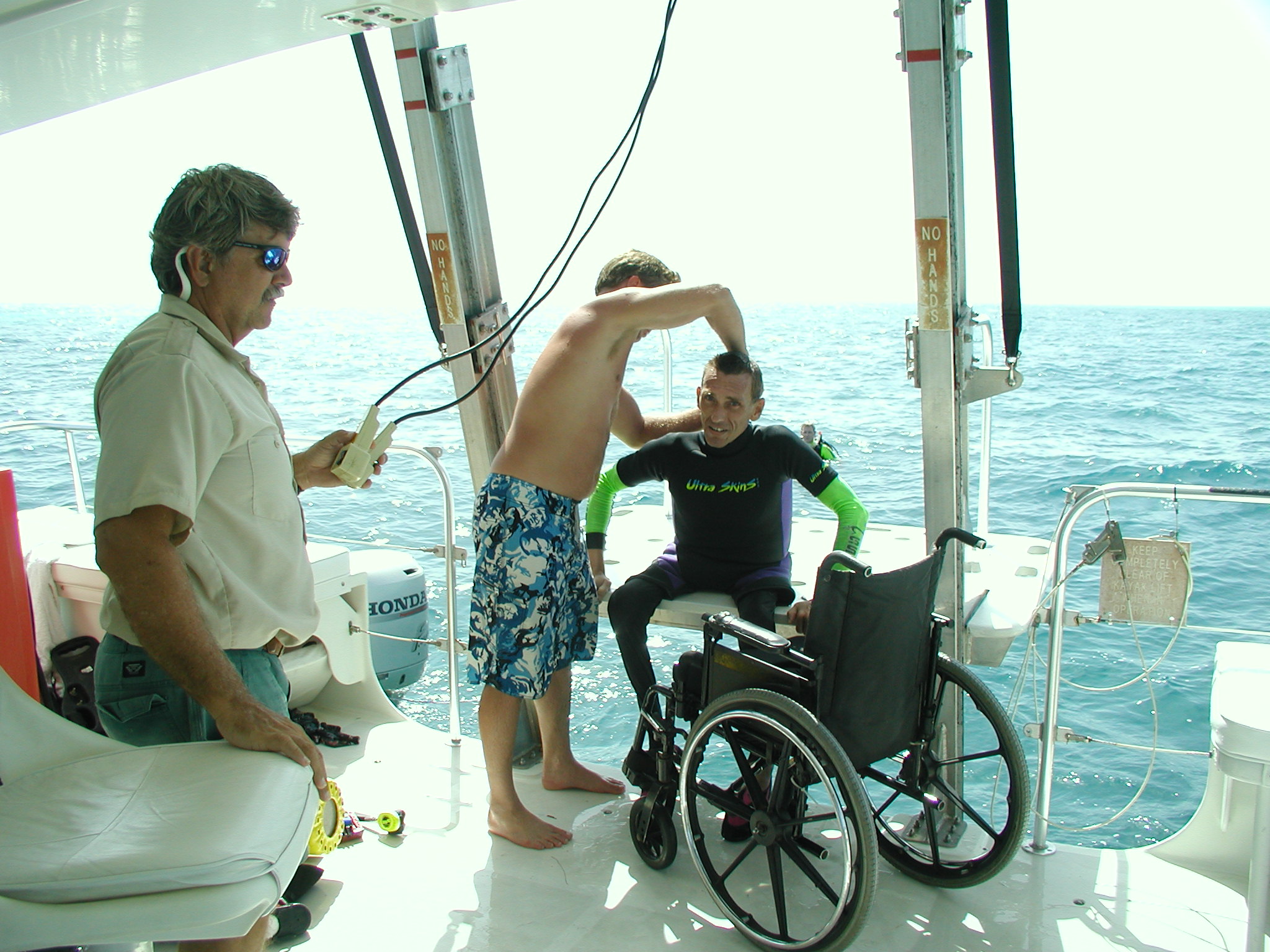
8. Attain NEUTRAL BUOYANCY, swim and EXPLORE the underwater environment for a minimum of twenty (20) minutes.
Skill Development Date completed Incomplete [ ]
9. MARINE LIFE IDENTIFICATION: Find, descended and identify one form of marine life.
II.C.36 [R] Date completed Incomplete [ ]
10. Partially FLOOD and CLEAR the face mask of water, then ASCEND to the surface using the ascent line.
11 BUOYANCY CHECK for neutral buoyancy at the surface with lungs inflated, and 500 psi/50 bar tank pressure.
Record OPEN WATER WEIGHT needed lbs/kilos
II.C.5 [R] Date completed Incomplete [ ]
12. Swim to exit point, remove scuba and exit the water
II.C.3 [R] Date completed Incomplete [ ]
LOG THE DIVE
1987 1999 Handicapped Scuba Association International Instructor’s Manual
Dive Number. Location:__________________________________
Date: Bottom Time: minutes.
Depth: feet/meters Cumulative Bottom Time: minutes.
Visibility: feet/meters. Water Temperature: 0F/C
Observations:____________________________________________________________________________________________________________________________________________________________________________________________________________________________________________________________________________________________________________________________
1987 1999 Handicapped Scuba Association International Instructor’s Manual
OPEN WATER LESSON PLANS Lesson 2
Date: Location:_______________________________________________________
Open Water Lesson 2 will introduce and evaluate the SCUBA Buddy System, Alternate Breathing between snorkel and regulator, Recover and clear regulator second stage at the surface and underwater, monitor air supply, depth & bottom time, ascend without a line. Continue evaluating Open Water Lesson 1. IIC: 1, 2, 3, 4, 5, 6, 7, 8, 9, and 13.
Skills Standards Challenged
1. Buddy System . II.C. 10 [D]
2. Alternate breathing between regulator & snorkel. II.C. 11 [C]
3. Clear regulator at the surface and under water. II.C. 16
4. Recover regulator at the surface and underwater. II.C. 17 [C SPR]
5. Use submersible gauges to monitor air supply, depth, and bottom time. II.C. 27, 28, 29
6. Ascend to the surface without an ascent line. II.C. 30 [B] [C SPR]
1. Don, Adjust, and Buddy Check SCUBA equipment.
Skill Development Date completed Incomplete [ ]
2. Enter the water, BUDDY CHECK SCUBA equipment Remove, defog, and clear face mask of water.
Skill Development Date completed Incomplete [ ]
3. Check buoyancy, rum over at the surface and surface. Inflate the BCD at the surface orally and with the low-pressure inflator.
Skill Development Date completed Incomplete [ ]
4. Recover regulator second stage from behind the shoulder and clear of water while at the surface.
II.C. 16 [R] Date completed Incomplete [ ]
II.C. 17 [C SPR] Date completed Incomplete [ ]
5. Alternate breathing between the snorkel and regulator while at the surface.
II.C.11[C] Date completed Incomplete [ ]
6. Use the BUDDY SYSTEM at the surface and underwater by remaining within reach of the Buddy Scuba Diver.
II.C.10 [B] Date completed Incomplete [ ]
7. DEFLATE the BCD at the surface and DESCEND using a descent line. EQUALIZE pressure in air spaces.
Skill Development Date completed Incomplete [ ]
8. Use the low-pressure inflator to adjust buoyancy underwater.
Skill Development Date completed Incomplete [ ]
1987 1999 Handicapped Scuba Association International Instructor's Manual
9. MONITOR instruments and throughout the dive. READ and give AIR PRESSURE, check deepest DEPTH and BOTTOM TIME.
II.C.27 [R] Date completed Incomplete [ ]
II.C.28 [R] Date completed Incomplete [ ]
II.C.29 [R] Date completed Incomplete [ ]
10. REMOVE, REPLACE and CLEAR REGULATOR SECOND STAGE of water, while underwater.
II.C.16 [R] Date completed Incomplete [ ]
11. RECOVER regulator second stage from behind shoulder while underwater.
II.C.17 [C SPR] Date completed Incomplete [ ]
12. FLOOD and CLEAR the face mask of water while underwater.
Skill Development Date completed Incomplete [ ]
13. SWIM and EXPLORE the underwater environment for a period of at least twenty (20) minutes.
Skill Development Date completed Incomplete [ ]
14. MARINE LIFE IDENTIFICATION: Find, describe and identify one form of marine life.
1987 1999 Handicapped Scuba Association International Instructor’s Manual
II.C.36 [R] Date completed Incomplete [ ]
15. ASCEND to the surface without an ascent line, breathing normally on SCUBA, at a steady rate of 30 feet/9m per minute WHILE LOOKING UP AND AROUND.
II.C 30 [B][C SPR] Date completed Incomplete [ ]
16. Exit water
1
Dive Number: Location:_______________________________
Date:________________________Bottom Time:_________________minutes
Depth: feet/meters Cumulative Bottom Time:_____________minutes
Visibility: feet/meters Water Temperature: 0F/C
Observations:__________________________________________________________________________________________________________________________________________________________________________________________________________________________________________
7. LOG THE DIVE
OPEN WATER LESSON PLANS Lesson 3
.
Date:____________________Location:_____________________________________________
Open Water Lesson 3 will introduce and evaluate buoyancy control underwater and during ascents; breathing from a free flowing regulator, buddy breathing; and the use of the alternate air source. Continue to evaluate Open Water Lesson 2. II.C: 3, 4, 6, 8, 9, 10, 11, 16, 17, 27, 28, and 29.
Skills Standards Challenged
I. Neutral Buoyancy underwater. II.C. 15 [C SPR]
2. Breathe from free flowing regulator. II.C. 18
3. Buddy breathe. II.C. 21 [B]
4. Alternate air source use, octopus regulator. II.C. 221 [ C SPR]
5. Alternate air source use, Integrated Power Inflator. U.C. 23 [B] [C SPR]
6. Buoyancy controlled ascent. II.C. 31 [C]
1. Don, Adjust, and Buddy Check SCUBA equipment.
Skill Development Date completed Incomplete [ ]
1987 1999 Handicapped Scuba Association International Instructor’s Manual
2. Enter the water, BUDDY CHECK SCUBA equipment; Remove, defog and clear the face mask of water.
Skill Development Date completed Incomplete [ ]
3. Check buoyancy, turn over at the surface and swim to dive site. INFLATE the BCD at the surface ORALLY and with the LOW PRESSURE INFLATOR.
Skill Development Date completed Incomplete [ ]
4. RECOVER the regulator from behind the shoulder, and Alternate breathing between the snorkel and regulator at the surface.
Skill Development Date completed Incomplete [ ]
5. Use the BUDDY SYSTEM; DEFLATE the BCD and DESCEND together using a descent line while maintaining neutral buoyancy.
H.C.15 [C SPR] Date completed Incomplete [ ]
6. MAINTAIN neutral buoyancy and swim underwater at various depths for a period of at least twenty (20) minutes.
II.C.15 [C SPR] Date completed Incomplete [ ]
7. MARINE LIFE IDENTIFICATION: Find, describe and identify one form of marine life.
II.C.36 [R] Date completed Incomplete [ ]
9. MONITOR and COMMUNICATE AIR PRESSURE, DEPTH and BOTTOM TIME to dive buddy.
Skill Development Date complete__________________Incomplete [ ]
1987 1999 Handicapped Scuba Association International Instructor’s Manual
OPEN WATER LESSON PLANS Lesson 4
Date: Location:_____________________________________________
Open Water Lesson 4 will introduce and evaluate the buoyancy controlled descent, mask removal, emergency swimming ascent, and emergency swimming ascent using alternate air source.
Continue to evaluate Open Water Lessons 1, 2, and 3. IIC: 3, 4, 5, 8, 10, 11, 15, 16, 17, 2 1, 22, 27, 28, 29 and 31.
Skills Standards Challenged
1. Buoyancy controlled Descent. II.C. 12 [C SPRI] 14 [C SPRI]
2. Mask Removal. II.C. 19 [C SPR]
3. Controlled Emergency Swimming Ascent (CESA). II.C. 24 [C SPR]
4. CESA using an Alternate Air Source. H.C. 25 [C SPR]
5. CESA using an Integrated Power Inflator Regulator. II.C.26 [B][C SPR]
1. Don, adjust and Buddy Check SCUBA equipment.
2. Enter the water, Buddy Check SCUBA equipment; Remove, Defog, and Clear the face mask of water.
Skill Development Date completed Incomplete [ ]
3. Check Buoyancy, turn over at the surface and swim to dive site. Inflate the Buoyancy Control Device at the surface orally and with the low-pressure inflator.
Skill Development Date completed Incomplete [ ]
4. Recover the regulator second stage from behind the shoulder, and alternate breathing between the snorkel and regulator at the surface.
Skill Development Date completed Incomplete [ ]
5. Deflate the buoyancy control device and perform a buoyancy controlled feet first descent. Stop and hover during the descent for a period of at least one (1) minute, then continue to the bottom; stop and hover above it without touching bottom.
II.C. 12 [C SPR] Date completed Incomplete [ ]
II.C. 14 [C SPR] Date completed Incomplete [ ]
6. Maintain the buddy system and neutral buoyancy while swimming under water at various depths for a period of at least twenty (20) minutes.
Skill Development Date completed Incomplete [ ]
7. Perform a controlled emergency swimming ascent and orally inflate the buoyancy control device at the surface.
II.C. 24 [C SPR] Date completed Incomplete [ ]
8. MARINE LIFE IDENTIFICATION: Find, describe and identify one form of marine life.
II .C.36 [R] Date completed Incomplete [ ]
1987 1999 Handicapped Scuba Association International Instructor’s Manual
9. Use the buddy system and perform a buoyancy controlled feet first descent; Stop and Hover part way down for a period of at least one (1) minute; Then continue to the bottom, stop and hover without touching the bottom.
Skill Development: Date completed Incomplete [ ]
10. Recover the regulator from behind the shoulder. Buddy breath from a single regulator stationary for a period of at least one (1) minute as the receiver of and one (1) minute, as the donor of air.
Skill Development Date completed Incomplete [ ]
11. Breathe from another SCUBA divers alternate air source octopus regulator, stationary for a period of at least one (1) minute; Then ascend to the surface and attain positive buoyancy by orally inflating the BCD. Perform both as the receiver and as the donor of air.
II.C. 25 [C SPR] Date completed Incomplete [ ]
12. Use the buddy system and perform a bu6yancy controlled feet first descent; Stop and Hover part way down for a period of at least one (1) minute; Then continue to the bottom, and hover above it without touching bottom.
Skill Development Date completed Incomplete [ ]
13. Completely remove the face mask; Breathe from SCUBA for a period of at least one (1) minute; Then replace and clear the mask of water.
II.C. 19 [C-SPR] Date completed Incomplete [ ]
14. Use submersible gauges to monitor AIR PRESSURE, BOTTOM TIME and DEEPEST DEPTH.
15. Breathe from another SCUBA diver's alternate air source integrated regulator, stationary for one (1) minute, then begin, ascent toward the surface at a rate of 30ft/9m per minute. Stop mid water and hover for one (1) minute, then continue ascent. At the surface, attain positive buoyancy by orally inflating, BCD. Perform both as the donor and as the receiver of air. Both donor and receiver must secure their own air source.
II.C.26 [B] [C SPR] Date completed Incomplete [ ]
16. LOG THE DIVE.
Dive Number: Location:_______________________________
Date:________________________Bottom Time:_________________minutes
Depth: feet/meters Cumulative Bottom Time:_____________minutes
Visibility: feet/meters Water Temperature: 0F/C
Observations:_______________________________________________________________________________________________________________________________________________________________________________________________________________________________________________________
1987 1999 Handicapped Scuba Association International Instructor's Manual
OPEN WATER LESSON PLANS Lesson 5
Date: Location:________________________________________________
Open Water Lesson 5 will introduce and evaluate Swimming proficiency at the surface and underwater, tired buddy tows, Towing while ventilating, Ascent without a face mask, and pacing activities. Continue to evaluate Lesson 4. skills. IIC: 4, 8, 10, 11, 12, 14, 15 ,25, 28 ,29, 30, and 31.
Skills Standards Challenged
1. Swim at the surface 300 yds/275m. II.C. 35 [C SPR]
2. Tow a fully equipped SCUBA diver. II. C. 33 [B]
3. Remove a buddy's SCUBA equipment. II. B. 17 [B]
4. Transport with close contact. II. B. 16 [B]
5. In water ventilation. II. B. 18 [B]
6. Swim underwater, obstructions. II.C. 32 [C SPR]
7. Ascent without face mask. II.C. 20 [C SPR]
8. Pace activities. II.C. 34
1. Don, adjust and Buddy check SCUBA equipment.
2. Enter the Water, Buddy check SCUBA equipment; Remove, defog, replace and clear the face mask of water.
Skill Development Date completed Incomplete [ ]
3. Check buoyancy, turn over at the surface and swim at least 300 yards/275m.
II.C.35 [C SPR] Date completed Incomplete [ ]
4. At the surface, orally inflate the buoyancy control device of another fully equipped SCUBA diver, and tow them a distance of at least 150 feet/45m.
II. B. 16 [B][LS] Date completed Incomplete [ ]
II. C. 33 [B][LS] Date completed Incomplete [ ]
5. Remove the face mask, snorkel, weight belt and SCUBA equipment of a buddy diver who is simulating unconsciousness.
II.B. l7 [B][LS] Date completed Incomplete [ ]
6. At the surface, tow the buddy who is simulating unconsciousness while administering ventilations for a distance of at least 150 feet/45m.
II. B. 18 [B] [LS] Date completed Incomplete [ ]
7. Use the Buddy System, and perform a buoyancy controlled, feet first descent; Stop and hover part way down for a period of at least one (1) minute, then continue to the bottom; Stop and hover above it without touching.
Skill Development Date completed Incomplete [
1987 1999 Handicapped Scuba Association International Instructor’s Manual
3. Maintain the buddy system, and neutral buoyancy while swimming through weeds, kelp, and other obstructions representative of local diving conditions, for a period of at least twenty (20) minutes.
II.C.32 [C SPR] Date completed Incomplete [ ]
9. MARINE LIFE IDENTIFICATION: Find, describe and identify one form of marine life.
Il.C.36 [R] Date completed Incomplete [ ]
10. Completely remove the face mask under water and swim to the surface at a steady rate of 30 feet/9m per minute while breathing on SCUBA. Attain positive buoyancy and don face mask. Perform in at least 20 feet/6m of water.
II.C. 20 [C SPR] Date completed Incomplete [ ]
11. Use the Buddy System, and perform a buoyancy controlled, feet first descent; Stop and hover part way down for a period of at least one (1) minute, then continue to the bottom. Stop and hover above it without touching. (same as skill #7; repeat it)
Skill Development Date completed Incomplete [ ]
12. Use submersible gauges to monitor Air Pressure, Bottom Time and the Deepest Depth. Pace activities to prevent breathlessness.
II.C.34 [R] Date completed Incomplete [ ]
13. Perform a buoyancy controlled ascent at 30 feet/9m per minute; Stop 15 feet/4.5m below the surface and hover for three (3) minutes. Continue ascent to the surface; Attain positive buoyancy, and exit the water.
1
Dive Number__________________________ Location:________________________________
Date: Bottom Time: minutes
Depth: feet/meters Cumulative Bottom Tirne: minutes
Visibility: feet/meters Water Temperature: 0F/C
Observations:_________________________________________________________________________________________________________________________________________________________________________________________________________________________________________________________________________________________________________________________________
4. LOG THE DIVE
1987 1999 Handicapped Scuba Association International Instructor’s Manual
Peace, after a great dive!
1987 1909 Handicapped Scuba Association International Instructor’s Manual
INTERNAL REVENUE SERVICE DEPARTMENT OFTHE TREASURY
DISTRICT DIRECTOR
P. 0. BOX 2508
CINCINNATI, ON 45201
Employer Identification Number .
Date: November 5, 1997 31 1373622
DLN:
17053242855007
POSEIDON HANDICAP SCUBA.ADVENTURES Contact Person:
C/O MARK R RAUSCH D. A. DOWNING
305 OXFORD DR Contact Telephone Number:
FAIRBORN, ON 45324 2734 (513) 241 5199
Our Letter dated:
October 28, 1994
Addendum Applies:
NO
Dear Applicant:
This modifies our letter of the above date in which we stated that you would be treated as an organization that is not a private foundation until the expiration of your advance-ruling period.
Your exempt status under section 501(a) of the Internal Revenue Code as an organization described in section 501(c)(3) is still in effect. Based on the information you submitted, we have determined that you are not a private foundation within the meaning of section 509(a) of the Code because you are an organization of the type described in section 501(a)(1) and 170(b)(1)(A)(vi).
Grantors and contributors may rely on this determination unless the Internal Revenue Service publishes notice to the contrary. However, if you lose your section 509(a)(1) status, a grantor or contributor may not rely on this determination if he or she was in part responsible for, or was aware of, the act or failure to act, or the substantial or material change on the part of the organization that resulted in your loss of such status, or if he or she acquired knowledge that the Internal Revenue Service had given notice that you would no longer be classified as a section 509(a)(1) organization.
If we have indicated in the heading of this letter that an addendum applies, the addendum enclosed is an integral part of this letter.
Because this letter could help resolve any questions about your private foundation status, please keep it in your permanent records.
~2
POSEIDON HANDICAP SCUBA ADVENTURES
If you have any questions, please contact the person whose name and, telephone number are shown above.
Sincerely yours,
District Director
Enclosure: Addendum
POSEIDON HANDICAP SCUBA ADVENTURES
Guidelines under which private foundations may rely on this determination, for gifts, grants, and contributions made after March 13, 1989, were liberalized and published in Rev. Proc. 89 23, Cumulative Bulletin 1989 1, and page 844.
You are required to make available for public inspection a copy of your exemption application, and supporting documents, and this exemption letter. If you are required to file an annual information return, you are also required to make a copy of the return available for public inspection for three years after the return is due. Failure to make these documents available for public inspection may subject you to a penalty of $10 per day for each day there is a failure to comply (up to a maximum of $5,000 in the case of an annual return). See Internal Revenue Service Notice 88 120, 1988 2 C.B. 454, for additional information.
POSEIDON HANDICAP SCUBA ADVENTURES
8845 NW 11 th Place Gainesville, FL 32606
Poseidon Handicap Scuba Adventures
Board of Directors
Mr. Mark Rausch, PHSA
Chief Executive Officer
H.S.A. Course Director #28-614
PADI Master Scuba Diver Trainer #41317
SSI Advanced Open Water Instructor #3327
8845 NW 11th Place
Gainesville, FL 32606
(352) 371-1153
Mr. Larry Upright
H.S.A. Level B Diver
1864 Banberry Way
Tallahassee, Florida 21210
(850) 212-0324
Ms. Debra Welsh
PHSA Executive Assistant
15448 Wormer Ave
Redford Twp, MI
48239
POSEIDON HANDICAP SCUBA ADVENTURES is a 501 (c) (3) Organization

